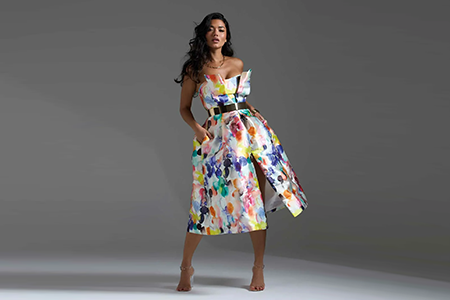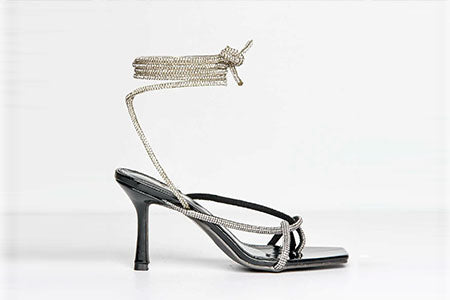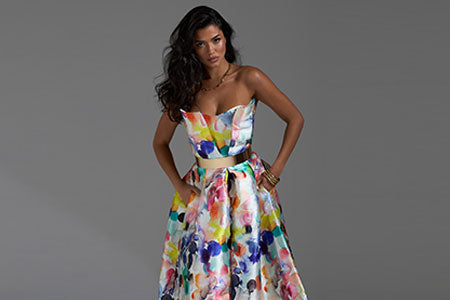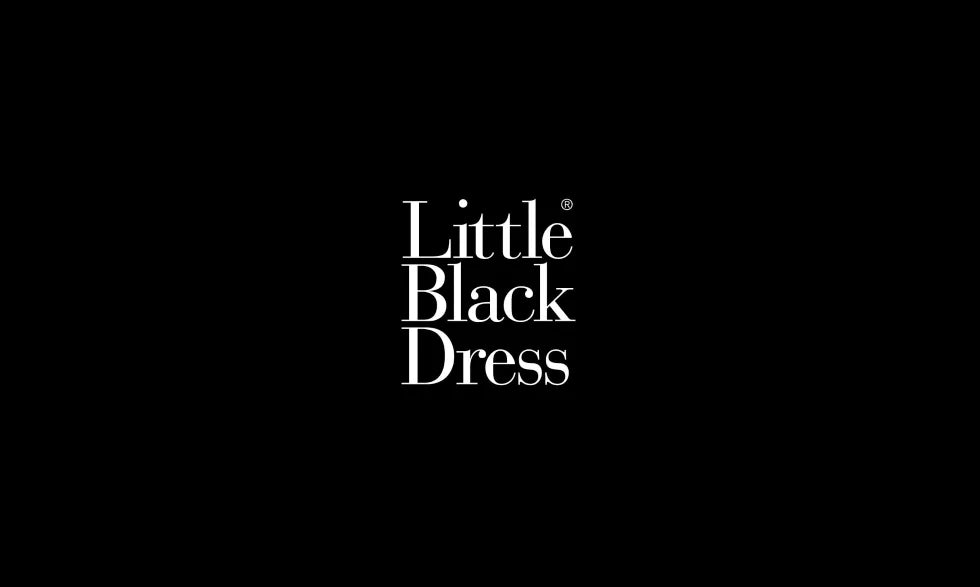
An ode to Coco
This Sunday, 129 years ago, one of the world's most acclaimed women of all time was born. She was Time magazine's only fashion designer to top the 100 Most Influential People of the Century list and it is with that in mind that we pay homage to the innovator of our namesake, and ultimate LBD icon, Coco Chanel.
 Born Gabrielle Bonheur Chanelon, on 19 August 1883 in Samur, France, Coco Chanel went from simple beginnings to revolutionising fashion, and courted her fair share of controversy along the way. She grew up in an orphanage after losing her mother at a young age and it was here that Chanel found solace in what would soon become her life's work, as she learned the trade of a seamstress. She soon learned to sew with more flourish than the nuns had been able to teach her, and when she turned 18, she took up work for a local tailor where her penchant for chic, simple designs became evident.
Years later Chanel would claim that when her mother died, her father sailed to America and she was sent to live with her two wicked (but rich) aunts. She even claimed to have been born in 1893 as opposed to 1883, and that her mother had died when Coco was six instead of 12. But this was all the stuff of fairytales and was done to diminish the stigma of poverty and orphanhood in 19th-century France – something Chanel continued to do throughout her adult life.
She replaced her tailor's role for the more lucrative lure of the stage in her early 20s and it was here, as a cabaret dancer, that Chanel earned the name ‘Coco' – a term of endearment for the ultimate party girl of the time. And party she did! Even Coco admitted she was a cocette, a 'kept woman', enjoying the company of older, richer men who made Chanel's rise and rise in the world of fashion possible. World War I led Chanel to hang up her dancing shoes and move to the resort town of Deauvile, France where she became the mistress of a rich ex-military officer and textile heir, Etienne Balsan. It was here that she started designing and creating hats as a diversion. But more important to Chanel's foray in fashion was her next lover, Arthur Edward Capel, who helped her to buy her first hat shop in Paris in 1910. Their relationship continued for nine years, even after Capel married someone else! When he died she told a friend, "His death was a terrible blow to me. In losing Capel, I lost everything. What followed was not a life of happiness I have to say."
It was whilst holidaying with Capel in Deauville in those happier years dressed in his over-sized jersey that Chanel really began to change the world of fashion for women. This was the era when the corset was mandatory. Women wore tightly laced bodices, full skirts, sometimes with cages and trains, bonnets and never dared to wear a dark, masculine colour palette. Yes, it was feminine, but it also made moving, eating, and Coco-style partying, troublesome. Chanel wanted to take control of what women wore. She felt that the post-World War I generation had gained more independence, they had had jobs and lives whilst the men went to fight and a corset simply wasn't appropriate any more. So Chanel introduced the versatile and comfortable jersey she had enjoyed borrowing from her lover to women's wardrobes as well as the shirt and tie for women, the boater hat, the monochrome pump, the suit set and later the ultimate symbol of independent femininity, the little black dress. Of course, these styles soon became very popular with clients, a generation of women who earned their own money and owned their own businesses, a generation for whom restricted clothing was now old-fashioned and impractical.
Born Gabrielle Bonheur Chanelon, on 19 August 1883 in Samur, France, Coco Chanel went from simple beginnings to revolutionising fashion, and courted her fair share of controversy along the way. She grew up in an orphanage after losing her mother at a young age and it was here that Chanel found solace in what would soon become her life's work, as she learned the trade of a seamstress. She soon learned to sew with more flourish than the nuns had been able to teach her, and when she turned 18, she took up work for a local tailor where her penchant for chic, simple designs became evident.
Years later Chanel would claim that when her mother died, her father sailed to America and she was sent to live with her two wicked (but rich) aunts. She even claimed to have been born in 1893 as opposed to 1883, and that her mother had died when Coco was six instead of 12. But this was all the stuff of fairytales and was done to diminish the stigma of poverty and orphanhood in 19th-century France – something Chanel continued to do throughout her adult life.
She replaced her tailor's role for the more lucrative lure of the stage in her early 20s and it was here, as a cabaret dancer, that Chanel earned the name ‘Coco' – a term of endearment for the ultimate party girl of the time. And party she did! Even Coco admitted she was a cocette, a 'kept woman', enjoying the company of older, richer men who made Chanel's rise and rise in the world of fashion possible. World War I led Chanel to hang up her dancing shoes and move to the resort town of Deauvile, France where she became the mistress of a rich ex-military officer and textile heir, Etienne Balsan. It was here that she started designing and creating hats as a diversion. But more important to Chanel's foray in fashion was her next lover, Arthur Edward Capel, who helped her to buy her first hat shop in Paris in 1910. Their relationship continued for nine years, even after Capel married someone else! When he died she told a friend, "His death was a terrible blow to me. In losing Capel, I lost everything. What followed was not a life of happiness I have to say."
It was whilst holidaying with Capel in Deauville in those happier years dressed in his over-sized jersey that Chanel really began to change the world of fashion for women. This was the era when the corset was mandatory. Women wore tightly laced bodices, full skirts, sometimes with cages and trains, bonnets and never dared to wear a dark, masculine colour palette. Yes, it was feminine, but it also made moving, eating, and Coco-style partying, troublesome. Chanel wanted to take control of what women wore. She felt that the post-World War I generation had gained more independence, they had had jobs and lives whilst the men went to fight and a corset simply wasn't appropriate any more. So Chanel introduced the versatile and comfortable jersey she had enjoyed borrowing from her lover to women's wardrobes as well as the shirt and tie for women, the boater hat, the monochrome pump, the suit set and later the ultimate symbol of independent femininity, the little black dress. Of course, these styles soon became very popular with clients, a generation of women who earned their own money and owned their own businesses, a generation for whom restricted clothing was now old-fashioned and impractical.
 By 1926 Coco Chanel had become an established fashion designer and well known fashion icon herself with her sharp bob and tanned skin (Chanel wore her tan as a symbol of her success and a way to hide her meager upbringing since only those who could afford to holiday would have the opportunity to become bronzed in the 20s), and it was in this year that she designed the little black dress. Chanel took a colour previously only associated with mourning and showed just how chic and sophisticated it could look as evening wear. In its first incarnation the little black dress was made with thin silk and had long sleeves. At the time Vogue magazine named Chanel's black dress the 'little boy look' and predicted that it would become the uniform for 'all women of taste'. And it did. Anything coming out of the House of Chanel was already a huge success as Chanel's clothes symbolised confidence and freedom. The little black dress was no different but it surpassed Chanel's previous creations because it allowed women to be womanly again but on their own terms, in a colour culture had forbidden them to wear outside of a funeral. But the women of the late 20s weren't thinking about attending funerals; they were anticipating luxurious dinners and parties and the dresses they could wear to them. Thus the little black dress also provided normal women with a glimpse of the life their idol, the poster girl for a life of luxury, might live. With her LBD, Chanel ultimately revolutionised women's dressing; this was the first example of power dressing but it still felt feminine and fashionable.
Coco Chanel was also the first designer to put her name on a perfume – the iconic Chanel No. 5. This opened up a whole new world of luxury fashion and is today a huge part of our most successful fashion house's fame and fortune.
During the economic depression of the 30s however Chanel's empire began to suffer and when World War II broke out in 1939 she shut her shops saying that it was ‘not the time for fashion'. During the German occupation of France, Chanel became involved with a Nazi officer who made it possible for Chanel to reside at the Ritz Hotel. This relationship fuelled growing beliefs that Chanel, who had been brought up by anti-Semitic nuns and mixed with the social elite who despised Jews for their power in French business, was a collaborator for the Germans. Chanel was interrogated when the war ended but not charged, though this is thought to have been because of her close but platonic relationship with Winston Churchill.
By 1926 Coco Chanel had become an established fashion designer and well known fashion icon herself with her sharp bob and tanned skin (Chanel wore her tan as a symbol of her success and a way to hide her meager upbringing since only those who could afford to holiday would have the opportunity to become bronzed in the 20s), and it was in this year that she designed the little black dress. Chanel took a colour previously only associated with mourning and showed just how chic and sophisticated it could look as evening wear. In its first incarnation the little black dress was made with thin silk and had long sleeves. At the time Vogue magazine named Chanel's black dress the 'little boy look' and predicted that it would become the uniform for 'all women of taste'. And it did. Anything coming out of the House of Chanel was already a huge success as Chanel's clothes symbolised confidence and freedom. The little black dress was no different but it surpassed Chanel's previous creations because it allowed women to be womanly again but on their own terms, in a colour culture had forbidden them to wear outside of a funeral. But the women of the late 20s weren't thinking about attending funerals; they were anticipating luxurious dinners and parties and the dresses they could wear to them. Thus the little black dress also provided normal women with a glimpse of the life their idol, the poster girl for a life of luxury, might live. With her LBD, Chanel ultimately revolutionised women's dressing; this was the first example of power dressing but it still felt feminine and fashionable.
Coco Chanel was also the first designer to put her name on a perfume – the iconic Chanel No. 5. This opened up a whole new world of luxury fashion and is today a huge part of our most successful fashion house's fame and fortune.
During the economic depression of the 30s however Chanel's empire began to suffer and when World War II broke out in 1939 she shut her shops saying that it was ‘not the time for fashion'. During the German occupation of France, Chanel became involved with a Nazi officer who made it possible for Chanel to reside at the Ritz Hotel. This relationship fuelled growing beliefs that Chanel, who had been brought up by anti-Semitic nuns and mixed with the social elite who despised Jews for their power in French business, was a collaborator for the Germans. Chanel was interrogated when the war ended but not charged, though this is thought to have been because of her close but platonic relationship with Winston Churchill.
 The end of the war saw Chanel rise up to reclaim her title as the Queen Bee of women's fashion and she successfully rebuilt the legendary Chanel Empire that still excels today at the helm of her monochrome-loving counterpart, Karl Lagerfeld. After the war she also took on Christian Dior's overtly feminine New Look collection, introducing her signature boxy jackets and trouser suits for women to the label. The collection was a huge hit in the US and was sported by Hollywood's finest, Grace Kelly and Audrey Hepburn, who would later become as synonymous with our favourite black dress as the great designer herself.
Chanel died in 1971 aged 87 and today there are over 300 Chanel stores worldwide making the label around £3 billion every year Рthat's a lot of little black dresses!
Looking back it is clear to see that it was Chanel's refusal to follow trends and her ability to revive her own sense of style every season that made her and her label not only iconic, but relevant, then and many years later.
In memory of the late, great LBD connoisseur, we've compiled a collection of classic little black dresses and timeless accessories to bring out the inner Chanel in you all. Shop the collection here.
The end of the war saw Chanel rise up to reclaim her title as the Queen Bee of women's fashion and she successfully rebuilt the legendary Chanel Empire that still excels today at the helm of her monochrome-loving counterpart, Karl Lagerfeld. After the war she also took on Christian Dior's overtly feminine New Look collection, introducing her signature boxy jackets and trouser suits for women to the label. The collection was a huge hit in the US and was sported by Hollywood's finest, Grace Kelly and Audrey Hepburn, who would later become as synonymous with our favourite black dress as the great designer herself.
Chanel died in 1971 aged 87 and today there are over 300 Chanel stores worldwide making the label around £3 billion every year Рthat's a lot of little black dresses!
Looking back it is clear to see that it was Chanel's refusal to follow trends and her ability to revive her own sense of style every season that made her and her label not only iconic, but relevant, then and many years later.
In memory of the late, great LBD connoisseur, we've compiled a collection of classic little black dresses and timeless accessories to bring out the inner Chanel in you all. Shop the collection here.
 The Pretty Dress Company Mayfair Dress, £95, The Paula Bolton Company Peacock Earrings, £17, Bernshaw Logan Dress, £299, The Paula Bolton Company Pearl Necklace, £45.
The Pretty Dress Company Mayfair Dress, £95, The Paula Bolton Company Peacock Earrings, £17, Bernshaw Logan Dress, £299, The Paula Bolton Company Pearl Necklace, £45.
 Born Gabrielle Bonheur Chanelon, on 19 August 1883 in Samur, France, Coco Chanel went from simple beginnings to revolutionising fashion, and courted her fair share of controversy along the way. She grew up in an orphanage after losing her mother at a young age and it was here that Chanel found solace in what would soon become her life's work, as she learned the trade of a seamstress. She soon learned to sew with more flourish than the nuns had been able to teach her, and when she turned 18, she took up work for a local tailor where her penchant for chic, simple designs became evident.
Years later Chanel would claim that when her mother died, her father sailed to America and she was sent to live with her two wicked (but rich) aunts. She even claimed to have been born in 1893 as opposed to 1883, and that her mother had died when Coco was six instead of 12. But this was all the stuff of fairytales and was done to diminish the stigma of poverty and orphanhood in 19th-century France – something Chanel continued to do throughout her adult life.
She replaced her tailor's role for the more lucrative lure of the stage in her early 20s and it was here, as a cabaret dancer, that Chanel earned the name ‘Coco' – a term of endearment for the ultimate party girl of the time. And party she did! Even Coco admitted she was a cocette, a 'kept woman', enjoying the company of older, richer men who made Chanel's rise and rise in the world of fashion possible. World War I led Chanel to hang up her dancing shoes and move to the resort town of Deauvile, France where she became the mistress of a rich ex-military officer and textile heir, Etienne Balsan. It was here that she started designing and creating hats as a diversion. But more important to Chanel's foray in fashion was her next lover, Arthur Edward Capel, who helped her to buy her first hat shop in Paris in 1910. Their relationship continued for nine years, even after Capel married someone else! When he died she told a friend, "His death was a terrible blow to me. In losing Capel, I lost everything. What followed was not a life of happiness I have to say."
It was whilst holidaying with Capel in Deauville in those happier years dressed in his over-sized jersey that Chanel really began to change the world of fashion for women. This was the era when the corset was mandatory. Women wore tightly laced bodices, full skirts, sometimes with cages and trains, bonnets and never dared to wear a dark, masculine colour palette. Yes, it was feminine, but it also made moving, eating, and Coco-style partying, troublesome. Chanel wanted to take control of what women wore. She felt that the post-World War I generation had gained more independence, they had had jobs and lives whilst the men went to fight and a corset simply wasn't appropriate any more. So Chanel introduced the versatile and comfortable jersey she had enjoyed borrowing from her lover to women's wardrobes as well as the shirt and tie for women, the boater hat, the monochrome pump, the suit set and later the ultimate symbol of independent femininity, the little black dress. Of course, these styles soon became very popular with clients, a generation of women who earned their own money and owned their own businesses, a generation for whom restricted clothing was now old-fashioned and impractical.
Born Gabrielle Bonheur Chanelon, on 19 August 1883 in Samur, France, Coco Chanel went from simple beginnings to revolutionising fashion, and courted her fair share of controversy along the way. She grew up in an orphanage after losing her mother at a young age and it was here that Chanel found solace in what would soon become her life's work, as she learned the trade of a seamstress. She soon learned to sew with more flourish than the nuns had been able to teach her, and when she turned 18, she took up work for a local tailor where her penchant for chic, simple designs became evident.
Years later Chanel would claim that when her mother died, her father sailed to America and she was sent to live with her two wicked (but rich) aunts. She even claimed to have been born in 1893 as opposed to 1883, and that her mother had died when Coco was six instead of 12. But this was all the stuff of fairytales and was done to diminish the stigma of poverty and orphanhood in 19th-century France – something Chanel continued to do throughout her adult life.
She replaced her tailor's role for the more lucrative lure of the stage in her early 20s and it was here, as a cabaret dancer, that Chanel earned the name ‘Coco' – a term of endearment for the ultimate party girl of the time. And party she did! Even Coco admitted she was a cocette, a 'kept woman', enjoying the company of older, richer men who made Chanel's rise and rise in the world of fashion possible. World War I led Chanel to hang up her dancing shoes and move to the resort town of Deauvile, France where she became the mistress of a rich ex-military officer and textile heir, Etienne Balsan. It was here that she started designing and creating hats as a diversion. But more important to Chanel's foray in fashion was her next lover, Arthur Edward Capel, who helped her to buy her first hat shop in Paris in 1910. Their relationship continued for nine years, even after Capel married someone else! When he died she told a friend, "His death was a terrible blow to me. In losing Capel, I lost everything. What followed was not a life of happiness I have to say."
It was whilst holidaying with Capel in Deauville in those happier years dressed in his over-sized jersey that Chanel really began to change the world of fashion for women. This was the era when the corset was mandatory. Women wore tightly laced bodices, full skirts, sometimes with cages and trains, bonnets and never dared to wear a dark, masculine colour palette. Yes, it was feminine, but it also made moving, eating, and Coco-style partying, troublesome. Chanel wanted to take control of what women wore. She felt that the post-World War I generation had gained more independence, they had had jobs and lives whilst the men went to fight and a corset simply wasn't appropriate any more. So Chanel introduced the versatile and comfortable jersey she had enjoyed borrowing from her lover to women's wardrobes as well as the shirt and tie for women, the boater hat, the monochrome pump, the suit set and later the ultimate symbol of independent femininity, the little black dress. Of course, these styles soon became very popular with clients, a generation of women who earned their own money and owned their own businesses, a generation for whom restricted clothing was now old-fashioned and impractical.
 By 1926 Coco Chanel had become an established fashion designer and well known fashion icon herself with her sharp bob and tanned skin (Chanel wore her tan as a symbol of her success and a way to hide her meager upbringing since only those who could afford to holiday would have the opportunity to become bronzed in the 20s), and it was in this year that she designed the little black dress. Chanel took a colour previously only associated with mourning and showed just how chic and sophisticated it could look as evening wear. In its first incarnation the little black dress was made with thin silk and had long sleeves. At the time Vogue magazine named Chanel's black dress the 'little boy look' and predicted that it would become the uniform for 'all women of taste'. And it did. Anything coming out of the House of Chanel was already a huge success as Chanel's clothes symbolised confidence and freedom. The little black dress was no different but it surpassed Chanel's previous creations because it allowed women to be womanly again but on their own terms, in a colour culture had forbidden them to wear outside of a funeral. But the women of the late 20s weren't thinking about attending funerals; they were anticipating luxurious dinners and parties and the dresses they could wear to them. Thus the little black dress also provided normal women with a glimpse of the life their idol, the poster girl for a life of luxury, might live. With her LBD, Chanel ultimately revolutionised women's dressing; this was the first example of power dressing but it still felt feminine and fashionable.
Coco Chanel was also the first designer to put her name on a perfume – the iconic Chanel No. 5. This opened up a whole new world of luxury fashion and is today a huge part of our most successful fashion house's fame and fortune.
During the economic depression of the 30s however Chanel's empire began to suffer and when World War II broke out in 1939 she shut her shops saying that it was ‘not the time for fashion'. During the German occupation of France, Chanel became involved with a Nazi officer who made it possible for Chanel to reside at the Ritz Hotel. This relationship fuelled growing beliefs that Chanel, who had been brought up by anti-Semitic nuns and mixed with the social elite who despised Jews for their power in French business, was a collaborator for the Germans. Chanel was interrogated when the war ended but not charged, though this is thought to have been because of her close but platonic relationship with Winston Churchill.
By 1926 Coco Chanel had become an established fashion designer and well known fashion icon herself with her sharp bob and tanned skin (Chanel wore her tan as a symbol of her success and a way to hide her meager upbringing since only those who could afford to holiday would have the opportunity to become bronzed in the 20s), and it was in this year that she designed the little black dress. Chanel took a colour previously only associated with mourning and showed just how chic and sophisticated it could look as evening wear. In its first incarnation the little black dress was made with thin silk and had long sleeves. At the time Vogue magazine named Chanel's black dress the 'little boy look' and predicted that it would become the uniform for 'all women of taste'. And it did. Anything coming out of the House of Chanel was already a huge success as Chanel's clothes symbolised confidence and freedom. The little black dress was no different but it surpassed Chanel's previous creations because it allowed women to be womanly again but on their own terms, in a colour culture had forbidden them to wear outside of a funeral. But the women of the late 20s weren't thinking about attending funerals; they were anticipating luxurious dinners and parties and the dresses they could wear to them. Thus the little black dress also provided normal women with a glimpse of the life their idol, the poster girl for a life of luxury, might live. With her LBD, Chanel ultimately revolutionised women's dressing; this was the first example of power dressing but it still felt feminine and fashionable.
Coco Chanel was also the first designer to put her name on a perfume – the iconic Chanel No. 5. This opened up a whole new world of luxury fashion and is today a huge part of our most successful fashion house's fame and fortune.
During the economic depression of the 30s however Chanel's empire began to suffer and when World War II broke out in 1939 she shut her shops saying that it was ‘not the time for fashion'. During the German occupation of France, Chanel became involved with a Nazi officer who made it possible for Chanel to reside at the Ritz Hotel. This relationship fuelled growing beliefs that Chanel, who had been brought up by anti-Semitic nuns and mixed with the social elite who despised Jews for their power in French business, was a collaborator for the Germans. Chanel was interrogated when the war ended but not charged, though this is thought to have been because of her close but platonic relationship with Winston Churchill.
 The end of the war saw Chanel rise up to reclaim her title as the Queen Bee of women's fashion and she successfully rebuilt the legendary Chanel Empire that still excels today at the helm of her monochrome-loving counterpart, Karl Lagerfeld. After the war she also took on Christian Dior's overtly feminine New Look collection, introducing her signature boxy jackets and trouser suits for women to the label. The collection was a huge hit in the US and was sported by Hollywood's finest, Grace Kelly and Audrey Hepburn, who would later become as synonymous with our favourite black dress as the great designer herself.
Chanel died in 1971 aged 87 and today there are over 300 Chanel stores worldwide making the label around £3 billion every year Рthat's a lot of little black dresses!
Looking back it is clear to see that it was Chanel's refusal to follow trends and her ability to revive her own sense of style every season that made her and her label not only iconic, but relevant, then and many years later.
In memory of the late, great LBD connoisseur, we've compiled a collection of classic little black dresses and timeless accessories to bring out the inner Chanel in you all. Shop the collection here.
The end of the war saw Chanel rise up to reclaim her title as the Queen Bee of women's fashion and she successfully rebuilt the legendary Chanel Empire that still excels today at the helm of her monochrome-loving counterpart, Karl Lagerfeld. After the war she also took on Christian Dior's overtly feminine New Look collection, introducing her signature boxy jackets and trouser suits for women to the label. The collection was a huge hit in the US and was sported by Hollywood's finest, Grace Kelly and Audrey Hepburn, who would later become as synonymous with our favourite black dress as the great designer herself.
Chanel died in 1971 aged 87 and today there are over 300 Chanel stores worldwide making the label around £3 billion every year Рthat's a lot of little black dresses!
Looking back it is clear to see that it was Chanel's refusal to follow trends and her ability to revive her own sense of style every season that made her and her label not only iconic, but relevant, then and many years later.
In memory of the late, great LBD connoisseur, we've compiled a collection of classic little black dresses and timeless accessories to bring out the inner Chanel in you all. Shop the collection here.
 The Pretty Dress Company Mayfair Dress, £95, The Paula Bolton Company Peacock Earrings, £17, Bernshaw Logan Dress, £299, The Paula Bolton Company Pearl Necklace, £45.
The Pretty Dress Company Mayfair Dress, £95, The Paula Bolton Company Peacock Earrings, £17, Bernshaw Logan Dress, £299, The Paula Bolton Company Pearl Necklace, £45.






Leave a comment
This site is protected by hCaptcha and the hCaptcha Privacy Policy and Terms of Service apply.